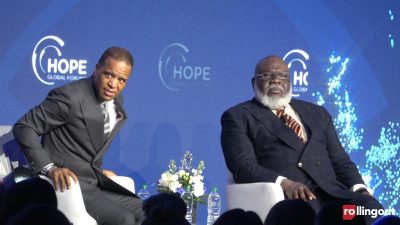
Worshiping is no longer confined to the walls of your local church. With nearly 3 billion people worldwide having access to the Internet, engaging in faith-based activities online using steaming services, social media, or apps is on a steady increase.
New research by AT&T found that 41 percent of those surveyed said they connect with faith-based organizations or inspirational websites using their cellphones, laptops or tablets. This is compared to 32 percent who said they attend church regularly, and 25 percent of this group said using a mobile device is a part of their regular worship experience.
Black worshipers were found to be most likely to use tech items for religious purposes, with 57 percent using this method. Hispanics used devices for faith-related reasons at 46 percent, while Asians were at 38 percent and Whites at 37 percent.
This method of praising God is becoming easier with the incline in apps and social media platforms becoming available to accommodate those who rather connect to their faith online. Jason Caston has created one of these platforms — the iChurch Method.
Caston, who serves as the digital lead for Bishop T.D. Jakes Ministries at The Potter’s House church, provides his service to churches whose members want to stay connected through streaming, a mobile app, and other means outside of physically attending service.
“We’re showing how there’s such an increase in how the Black church is gravitating toward utilizing technology — more specifically, mobile technology — in their base experience,” Caston told rolling out. “With me working with The Potter’s House, we see that a lot of the people connected with [iChurch], even the ones that step foot inside the sanctuary, have some type of digital connection with us.”
Although Caston’s iChurch service has connected with several other churches, he explains the impact his program has best when looking at statistics from The Potter’s House, a megachurch ranked the 10th largest church in the country by Outreach magazine.
“You may have 8,000 or 9,000 that come to the actual Potter’s House, but from a digital perspective, we have Twitter, Facebook, Instagram, our online steam, our mobile app, and Internet TV,” he said. “Some people are only able to see live tweets, so they’re only able to connect on Twitter, some people are in their living room watching [church service] via Internet TV. So we’re looking at our digital platform, which can be upwards of 50,000 to 100,000 people watching online. We call them church e-members.”
Caston’s program isn’t the only platform that’s taking worshipers to church via the web. YouVersion is a free app containing the Bible that can be downloaded on a mobile phone, tablet, and computer. Their app is available in over 700 languages and they even have a version for children.
“God is near, and so is His Word,” the YouVersion website reads. “When the Bible is always with you, it becomes a part of your daily life.”
But just because online worshiping is becoming more popular doesn’t mean it’s out to replace the tradition of gathering with people who share a common faith at a sacred building. What it does mean is that access to various elements of religion is possible now more than ever before, and this actually complements the purpose of the traditional church experience by spreading the gospel to anyone in the world, from anywhere in the world.
“We’re starting to see that the lines between online and offline are blurring continuously,” Caston said. “For every church-based offline experience we’re having, there’s an online component to it.”
To learn more about iChurch, visit www.ichurchmethod.com.










